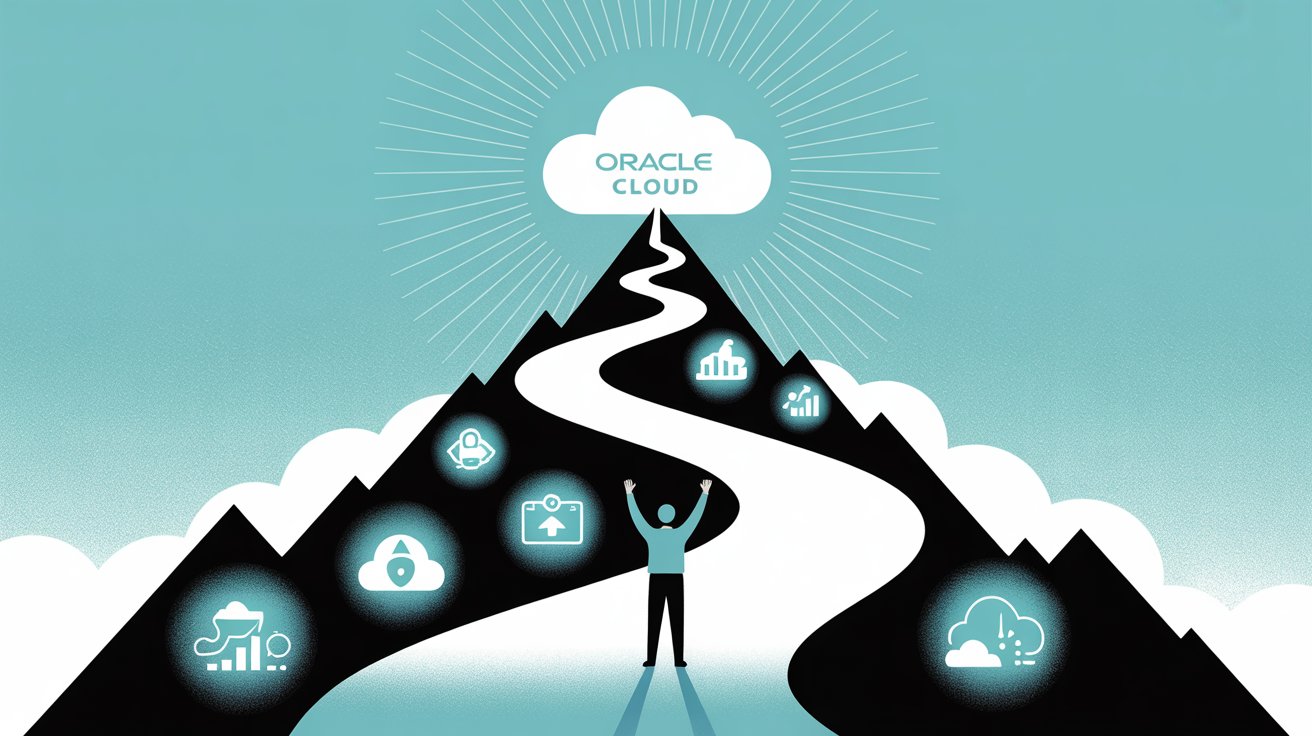Switching to Oracle Cloud can feel like a double-edged sword. On one hand, it offers improved tools and flexibility for your business. But on the other, the road to implementation is often challenging and full of surprises.
In fact, nearly 60% of cloud migrations hit delays due to common challenges like data issues or resistance from employees. These hurdles can slow progress and keep you from seeing results quickly.
This blog will guide you through addressing these obstacles effectively with practical strategies. Ready for solutions? Keep reading!
Key Takeaways
- Nearly 60% of cloud migrations face delays due to challenges like poor planning, data issues, and employee resistance.
- Lack of training and support can slow adoption and lead to errors. Workshops, help desks, and peer advocates ease the transition.
- Resistance to change disrupts progress; clear communication, leadership involvement, and small goals improve team morale.
- Complex data migration requires cleaning data, testing plans in controlled environments, employing automation tools, and expert guidance.
- Strong security measures like audits, multi-factor authentication (MFA), encryption protocols, and compliance focus protect sensitive information during migration.
Common Oracle Cloud Implementation Challenges
Tackling Oracle Cloud implementation often feels like navigating a maze with blindfolds on. Businesses frequently stumble into obstacles that slow progress or derail plans entirely.
Lack of employee training and support
Poor training can leave employees perplexed about new systems. Workers may find it challenging to operate Oracle Cloud efficiently without direction, impacting productivity. Insufficient support during this adjustment period leads to dissatisfaction and errors.
This obstacle often delays project timelines and diminishes trust in the technology.
Offering help desks or dedicated teams for user inquiries simplifies adoption challenges. For example, businesses that leverage managed support from Vigilant benefit from responsive assistance and tailored training that accelerates employee adoption. Frequent workshops can transform reluctant workers into assured users. As one business leader once said:.
A well-trained team is the backbone of any successful implementation.
Resistance to organizational change
Resistance to change often causes interruptions in cloud implementation projects. Employees may feel uneasy about adjusting workflows or learning new systems. Long-standing habits make it hard for teams to take full advantage of Oracle Cloud’s benefits.
These challenges can lead to delays, reduced productivity, and strained team morale.
Involved leaders play a vital role in addressing resistance. Clear communication about the reasons behind the shift helps build trust and ease concerns. Providing smaller goals during transitions keeps employees motivated.
Offering hands-on support fosters confidence in using new tools effectively while reducing frustration among staff members adapting to the changes ahead of them.
Complex data migration processes
Migrating data to Oracle Cloud often becomes complex. Aging systems, disorganized formats, and compatibility issues present significant obstacles. A single mismatch in fields can interfere with the entire transfer process.
These discrepancies hinder progress and risk essential information being lost or corrupted.
Businesses managing multiple platforms face even greater challenges. Combining older systems with modern cloud environments requires accuracy. Inadequate planning during this phase results in expensive delays and operational downtime.
Inadequate pre-implementation planning
Jumping from data migration without a solid plan often leads to negative outcomes. Insufficient pre-implementation planning can result in delays, budget overruns, and systems not aligning with business requirements.
Skipping thorough assessments increases the likelihood of missing critical integration or compatibility issues.
Teams occasionally neglect defining clear objectives at the outset. Without specific goals, projects can lose direction and waste resources. For guidance on aligning technical planning with financial readiness, you can refer this article to explore how equity financing supports long-term digital transformation goals. Unclear workflows or a lack of stakeholder involvement contribute to confusion during deployment phases.
As the saying goes:.
Failing to plan is planning to fail.
Security and compliance concerns
Data breaches can seriously harm businesses. Without adequate protections, sensitive data may be exposed to unauthorized parties. Oracle Cloud implementation presents risks if security measures and governance frameworks are insufficient.
Cyberattacks exploit weaknesses during migration or integration phases, jeopardizing critical systems.
Compliance introduces additional challenges. Businesses must adhere to regulations like GDPR, HIPAA, or CCPA, depending on their industry and location. Failing to meet these requirements leads to fines and harm to reputation.
Frequent audits and strict access controls are essential to maintaining compliance while safeguarding company assets from unauthorized access.
Strategies to Overcome Challenges
Tackling cloud implementation hurdles requires clear strategies and focused action. Stick to practical solutions that fit your team’s needs and capabilities.
Develop a comprehensive training and adoption plan
Proper training and adoption play a critical role in any cloud implementation. Without it, businesses risk low user participation and project failures.
- Identify skill gaps and assess the knowledge level of your team. This will highlight where additional training is required.
- Involve key employees early in the process to build confidence. Early participation reduces resistance to change.
- Offer hands-on workshops designed for specific roles within your company. Practical sessions help employees use tools effectively.
- Create simple, easy-to-follow training materials using videos, guides, or step-by-step instructions. Visual aids improve retention.
- Use online learning platforms that allow flexible schedules for employees with time constraints.
- Set milestones for adoption progress and track them closely. Monitoring ensures steady improvement across departments.
- Appoint internal advocates who can provide peer support during the transition. Employees often learn better from colleagues they trust.
- Gather feedback on training sessions to identify areas for improvement quickly.
- Schedule regular refresher courses post-implementation to keep skills sharp.
- Recognize employees who embrace the system quickly with acknowledgment or incentives, motivating others to follow suit as well!
Implement strong change management practices
Transitioning into new systems works best when people are open to the changes. Encouraging user adoption requires addressing resistance and bringing teams together efficiently.
- Start with clear communication. Explain why the change is happening and how it benefits employees and the organization. Use real-life examples to make the case relatable.
- Assign a dedicated change management team. Provide them with resources to identify challenges, address concerns, and monitor progress throughout the implementation.
- Involve employees early on. Seek feedback during planning stages to create a sense of engagement and reduce opposition to the project.
- Provide consistent updates. Share milestones, successes, or challenges openly through emails, meetings, or dashboards.
- Celebrate small wins. Recognize achievements during transitions to build momentum and inspire continued participation.
- Address resistance directly. Have open conversations with skeptical employees to understand their perspectives and clarify misconceptions.
- Offer incentives for adoption. Introduce rewards such as bonuses or recognition programs that encourage enthusiasm for learning new processes.
Follow best practices for data migration
Data migration during cloud implementation often feels complex. A clear strategy keeps the process smooth and reduces risks.
- Test your data migration plan in a controlled environment before going live. This step helps identify gaps and fixes issues early.
- Clean your data thoroughly to avoid transferring duplicates or outdated information. Poor data quality adds unnecessary problems post-migration.
- Employ automated tools to simplify repetitive tasks like transferring large datasets. Automation saves time and minimizes manual errors.
- Ensure that legacy systems align with Oracle Cloud requirements for compatibility. Mismatched formats can create integration challenges.
- Back up all critical files before starting the transfer process. Unexpected failures should not result in permanent losses.
- Work with IT professionals or consultants experienced in cloud migrations. Their expertise can help address unforeseen events efficiently.
Overcoming hurdles during migration sets your team up for success, but planning does not stop here!
Conduct thorough pre-implementation assessments
Preparation is key to reducing Oracle Cloud implementation risks. Proper evaluation helps align business goals and technology needs.
- Identify existing system limitations by reviewing processes and workflows. This highlights problem areas that the new system must address.
- Outline integration requirements like system connectivity and compatibility with other tools or software. This helps avoid future technical issues.
- Examine current data quality, structure, and flow for successful cloud migration and data transfer accuracy.
- Assess workforce readiness to identify skill gaps in user training and adoption strategies early on.
- Review security protocols to resolve compliance concerns before deployment begins.
- Gather stakeholder inputs to align organizational objectives with implementation plans from the beginning.
- Conduct trial runs of critical processes using cloud platforms to detect potential implementation challenges.
- Seek advice from external experts or Oracle specialists as needed to identify hidden issues early.
Thorough evaluations prevent costly mistakes during the actual deployment stages, saving both time and resources effectively!
Strengthen security measures and governance frameworks
Strong security and governance can prevent major risks during cloud implementation. Business owners must take active steps to protect data and maintain compliance.
- Conduct regular security audits to identify potential vulnerabilities in your system. Assess weak spots before attackers do.
- Assign a dedicated team to monitor access control and permissions across platforms. This reduces unauthorized entry risks.
- Develop clear governance policies that outline roles, responsibilities, and decision-making processes. These rules minimize confusion.
- Implement multi-factor authentication (MFA) for all users accessing the system. Extra verification keeps sensitive information safer.
- Ensure encryption protocols are active for both data at rest and in transit. Encryption scrambles data, making it harder to steal.
- Test disaster recovery plans regularly to confirm they work under pressure. Preparation minimizes downtime during breaches.
- Stay updated on local, state, and federal compliance laws applying to your industry. Non-compliance can result in heavy fines or legal problems.
- Limit third-party vendor access unless absolutely necessary for operations. Fewer connections mean fewer attack points.
- Train employees regularly on cybersecurity threats like phishing attempts or malware attacks. Educated staff are less likely to make critical mistakes.
- Allocate resources for tools that track suspicious behavior within your Oracle Cloud systems in real time. Early detection prevents larger issues later on.
Every step here strengthens your security foundation while supporting successful cloud migration efforts without major hiccups or delays.
Conclusion
Overcoming Oracle Cloud challenges takes effort but pays off. Focus on training your team and planning ahead. Tackle resistance to change with clear communication. Handle data migration carefully to avoid disruptions.
These steps will help you succeed in your cloud journey.































